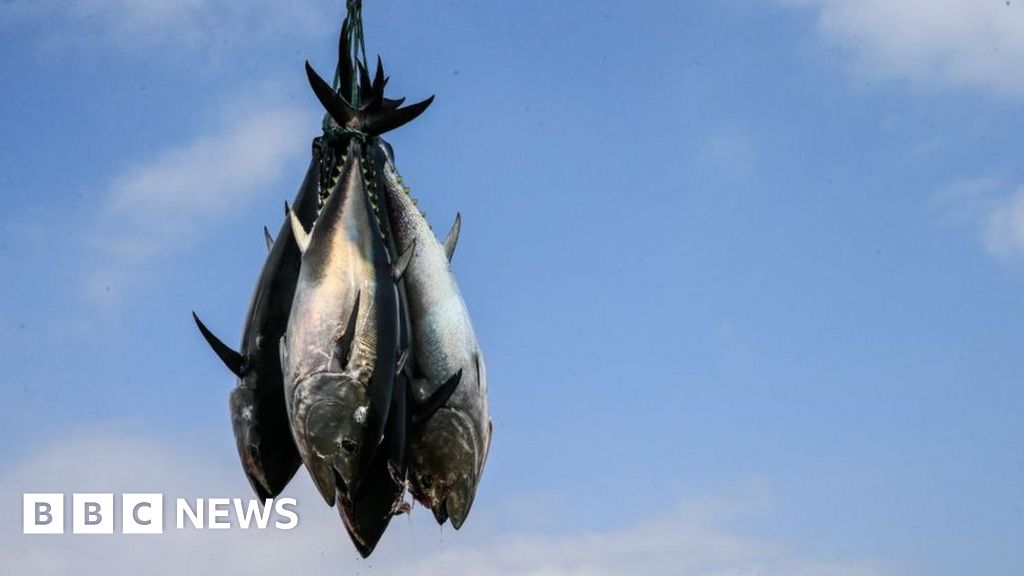Late last year, the Spanish government fined 25 Spanish-flagged fishing ships that had been operating near Argentina’s territorial waters.
The financial penalties were imposed because the vessels had illegally turned off the GPS-based automatic identification systems (AIS), which were transmitting their positions. This is often a sign that a vessel is engaged in illegal fishing.
“It’s estimated that illegal or unregulated fishing is as much as 20% of what’s caught,” says David Kroodsma, head of the research team at Global Fishing Watch.
“It’s estimated that illegal or unregulated fishing is as much as 20% of what’s caught,” says David Kroodsma, head of the research team at Global Fishing Watch.
This contributes significantly to overfishing, with the UN adding that a third of global fish stocks are now being fished beyond biologically sustainable levels. For example it’s estimated that the population of bluefin tuna, is just 2.6% of its historic, unfished size.
“Sharks and rays are at the brink of extinction,” says Mr Kroodsma. “You have extinction threats to sea birds and turtles from bycatch. It is really sad, because we could manage the oceans so much better.”
Global Fishing Watch is a partnership between Google, marine conservation body Oceana, and environmental group Skywatch. The latter studies satellite images to spot environmental damage.
To try to better monitor and quantify the problem of overfishing, Global Fishing Watch is now using increasingly sophisticated AI software, and satellite imagery, to globally map the movements of more than 65,000 commercial fishing vessels, both those with – and without – AIS.
Late last year, the Spanish government fined 25 Spanish-flagged fishing ships that had been operating near Argentina’s territorial waters.
“It’s estimated that illegal or unregulated fishing is as much as 20% of what’s caught,” says David Kroodsma, head of the research team at Global Fishing Watch.
The financial penalties were imposed because the vessels had illegally turned off the GPS-based automatic identification systems (AIS), which were transmitting their positions. This is often a sign that a vessel is engaged in illegal fishing.
This contributes significantly to overfishing, with the UN adding that a third of global fish stocks are now being fished beyond biologically sustainable levels. For example it’s estimated that the population of bluefin tuna, is just 2.6% of its historic, unfished size.
“It’s estimated that illegal or unregulated fishing is as much as 20% of what’s caught,” says David Kroodsma, head of the research team at Global Fishing Watch.
“It’s estimated that illegal or unregulated fishing is as much as 20% of what’s caught,” says David Kroodsma, head of the research team at Global Fishing Watch.
This contributes significantly to overfishing, with the UN adding that a third of global fish stocks are now being fished beyond biologically sustainable levels. For example it’s estimated that the population of bluefin tuna, is just 2.6% of its historic, unfished size.
“Sharks and rays are at the brink of extinction,” says Mr Kroodsma. “You have extinction threats to sea birds and turtles from bycatch. It is really sad, because we could manage the oceans so much better.”
Global Fishing Watch is a partnership between Google, marine conservation body Oceana, and environmental group Skywatch. The latter studies satellite images to spot environmental damage.
To try to better monitor and quantify the problem of overfishing, Global Fishing Watch is now using increasingly sophisticated AI software, and satellite imagery, to globally map the movements of more than 65,000 commercial fishing vessels, both those with – and without – AIS.
#prevent #illegal #fishing
Note:- (Not all news on the site expresses the point of view of the site, but we transmit this news automatically and translate it through programmatic technology on the site and not from a human editor. The content is auto-generated from a syndicated feed.))



